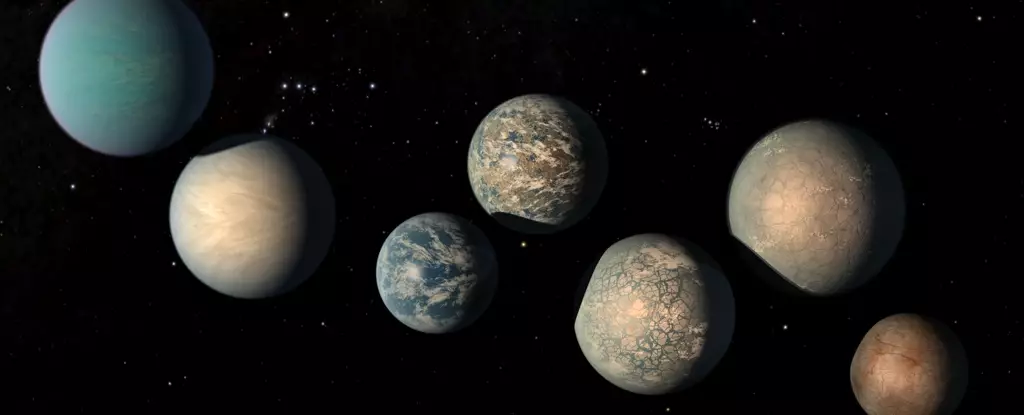Nestled a mere 40 light-years away from our pale blue dot lies the TRAPPIST-1 system, a remarkable cluster of seven exoplanets orbiting a red dwarf star. Since its discovery in February 2017, TRAPPIST-1 has captivated the imagination of scientists and dreamers alike, raising tantalizing questions about the potential for extraterrestrial life. With ongoing research suggesting the presence of water—an essential ingredient for life—this system holds immense promise for astrobiology. The excitement surrounding TRAPPIST-1 is infectious, but it must be tempered with critical examination of the unique dynamics that govern such planetary systems.
Red Dwarfs: Both Adversaries and Nurturers of Life
The TRAPPIST-1 star is classified as an M-type red dwarf, a category known for its compact size and lower temperatures compared to our Sun. This stellar type offers both advantages and challenges for the surrounding planets. While red dwarfs like TRAPPIST-1 have longer lifespans compared to larger stars, their propensity for flare activities poses a significant threat to any atmosphere that supports life. Astronomers have been meticulously probing the TRAPPIST-1 system for signs of habitable conditions, grappling with the reality that while water is essential, the very stars around which these planets orbit might make the retention of liquid water a difficult feat.
Recent research has reignited discussions around the availability of water in the TRAPPIST-1 system. Speculations about these planets being submerged in oceans of water are now being considered alongside concerns regarding how effectively they can maintain such vital resources in the face of harsh stellar radiation.
The Role of Water in Habitability
Water’s presence is often elevated as the cornerstone of life, yet the conditions necessary for its stability are complex. Observational data from the James Webb Space Telescope (JWST) has brought new insights into the atmospheres of these exoplanets. For instance, studies on one of the planets, TRAPPIST-1 c, have suggested a thinner atmosphere than previously imagined, decreasing its similarity to Venus. But does this finding mean a complete absence of water vapor? Not necessarily. The research led by astrobiologist Trent Thomas from the University of Washington shows that while TRAPPIST-1 c might lack a thick CO2-rich atmosphere, it could still harbor water vapor originating from volcanic activities.
This idea of volcanic outgassing introduces an intriguing theory about how these planets could sustain water sources. By creating a model based on the geochemical characteristics of rocky planets within our Solar System, researchers are seeking to provide a more nuanced understanding of what initializes and maintains water on these distant worlds.
Implications of Outgassing Rates
The findings suggest an outgassing rate that could considerably vary from one planet to another within the TRAPPIST-1 system. The theoretical model implies that these rates could be anywhere from a third to eight times greater than Earth’s, indicating that there is potential for volcanic activity to play a significant role in atmospheric composition. However, the excitement is tempered by caution; the rates of magma movement suggest that the TRAPPIST-1 planets could potentially be geologically inactive, sharing a fate similar to the currently dormant Mars.
The implications of low volcanic activity cannot be overlooked. If these planets are indeed experiencing diminished geologic activity, one of the foundational sources of sustained water could be undermined, challenging assumptions about their habitability. The team’s conclusions also hint that the composition of the mantle—whether it retains water—strongly correlates with the age and history of the TRAPPIST-1 system.
The Complex Landscape of Habitability
As scientists dissect the unique characteristics of TRAPPIST-1, the complexity of defining habitability becomes evident. These planets may display a range of environmental conditions—from barren, rocky landscapes to lush, water-rich worlds mimicking Earth. However, the possibility that they may have relatively dry mantles suggests a more nuanced classification system is necessary to understand their status fully.
Highlighting the intricacies of planetary evolution presents a thrilling yet daunting task for astronomers. Each new finding prompts more questions about planetary interiors, radiation effects, and the potential for life beyond our solar confines. As observations from the JWST and other instruments unfold, our perceptions of habitability in systems like TRAPPIST-1 may evolve significantly.
Ultimately, the study of the TRAPPIST-1 system serves as a crucial reminder that while we may dream of distant worlds filled with water and life, those dreams must be meticulously balanced with recognition of the multiple variables at play. Each discovery is a step closer to answering the age-old question of whether we are alone in the universe, leading us through uncharted territories of research and exploration.

